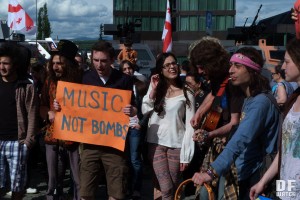
TBILISI, DFWatch – For the first time in Georgia’s history, the main celebration on Independence Day took place not in Tbilisi, the formal capital, but in Kutaisi, where a new parliament building was opened with a symbolic first session of lawmakers and a military parade.
Also the military parade, which used to be held in Tbilisi, was this year seen in Kutaisi. The city is Georgia’s second largest and lies in the middle of the western half of the country. President Saakashvili has said that he will make it an important center and moved many state institutions there, but he has not yet proclaimed it the new capital.
But Tbilisi did not remain quiet. Many events were held in the streets during the day. City Hall organized a parade of various products produced in Georgia like military arms, including the infantry combat vehicle Lazika and the armored vehicle Didgori; also Georgian made small airplanes, subway cars and tracks, metallurgical products. Then there were flowers, national varieties of cheese, honey, chocolate, clothes, shoes and uniforms. Other handicraft products were also available on display and for purchase.
The Georgian president and Tbilisi’s mayor both visited this “trade parade” on Rustaveli Avenue, the capital’s main thoroughfare. During his speech, Mikheil Saakashvili said that by 2015, Tbilisi’s metro system will extend all the way to Mtskheta, which lies 21 km to the north and is the old capital. And in the next two years, French tram cars will appear on streets of Tbilisi.
The president visited most of the small camps on the street displaying various food or other products. He took photos with children while getting into armored vehicles and planes displayed at the beginning of the parade.

There were various performances the whole day. Ensembles performed Georgian folk music on Freedom Square, both children and adult teams. The National Folk Ballet also performed, while onlookers crowded in front of them, clapping enthusiastically and snapping pictures.
In every corner there were small tables full of colored pencils and papers for children to draw and paint, there works were later displayed on nearby stands in the streets.
An orchestra caught up with military spirits on Roses Square, where a military pavilion was organized.
Several bands were playing music in front of Youth Palace, while bartenders gave a spectacular performance preparing cocktails to background music.
Everything was labeled ‘made in Georgia’. Even people presenting products or giving performances were dressed in clothes which said Made in Georgia.
Playgrounds for children were organized with different games, chess and backgammon for adults.
The parade ended with a small concert in the evening.
But meanwhile, a group of youth organized a rally in front of Rustaveli metro station. ‘Peace is the Answer’ was their message.
Their main cause is that it is not fair spending so many millions on the military, when it could have been used for social welfare.
“You’d better choose life than death in Afghanistan, pensions for honorable aging and not military weapons; education and not tanks; dormitories for students and not Lazika; peace and not war.”

The youth played Bob Dylan and John Lennon songs in the streets and formed peace signs by lying on the ground. Afterwards they demonstrated against the military pavilion by singing. Standing in a circle they sang a number of songs holding posters, which read ‘They sell war, we don’t buy’, ‘Music, not Bombs’, ‘Make tea not war’ and ‘make love not war’.
In short, it was a pacifist rally to celebrate Independence Day not with tanks and military parades but with music.
In the morning, Georgian Dream, the main opposition group in Georgia held a symbolic funeral for the victims of May 26 in 2011 at Sameba Cathedral in Tbilisi. One year ago, a mostly peaceful anti-government protest was held in front of parliament, at the same spot where a military parade was planned the next day. Shortly after midnight, a motley crowd of riot police, mixed in with various task forces as well as vigilantes dressed up to look like police, moved in on the demonstrators and exerted indiscriminate violence against those present. The result was at least four deaths, scores of injured, many beaten to a pulp. Among those beaten and shot with rubber bullets were around twenty journalists. The regime’s orgy of violence last year has harmed its image internationally.
Saturday people remembered those who died one year ago.
In Kutaisi, the first session of parliament was held in the new half-finished building. The president and the speaker of parliament symbolically installed a new window at the entrance. The president gave a speech. Also attending the session were representatives of foreign embassies, the government, the first lady and honorable guests.
A military parade was held after the session in front of the parliament building.
Following what has become a tradition, the Georgian president pardoned 66 prisoners in connection with the May 26 celebration.

